Backgammon is a game for two players, played on a board consisting of 24 triangles, which are usually painted in two different colors.
Every player owns a set of 15 checkers in either black or white and a pair of dice. The starting position is shown on the graphic below. Every player has their own home board in front of them. The two home boards are separated from the outer board by the bar. Depending on our position our home board can be on your left or right side, both is possible as long as the two home boards are on opposite sides of the board, facing each other.

The goal of the game is to first move all your checkers into your own home board and then bear them off. The first player who bears of all his pieces wins the game. The direction of the movement of the checkers for both players is shown on the graphic below.
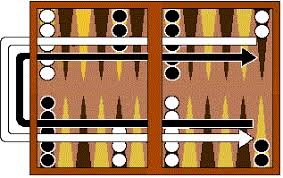
To figure out who starts each player has to roll a single die. If equal numbers come up, both players roll again until they roll different numbers. The player with the higher number starts by rolling both of his dice and moving his checkers towards his home board. The number shown on the dice indicates how many steps the player is allowed to move. These rules have to be followed:
- Checkers can only be moved forward.
- They can only move to open points, which are not covered by more than one of the opposing checkers.
- The two numbers on the dice are seen as two separate moves which can be used by different checkers. If both numbers are used to move the same piece both points must be open (Like in the example bellow).
- If a player rolls a double he plays twice the number shown on both dices. That way a double 6 means the player is allowed two move four times six with one to four checkers of his choice.
- A player must use all numbers of his roll as long as it is possible. If only one number can be played the player must play that number. When neither number can be played the player looses his turn.
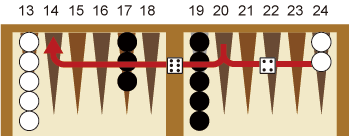
A single checkers can be hit if the other player’s checkers lands on it. The hit checkers is placed on the bar.
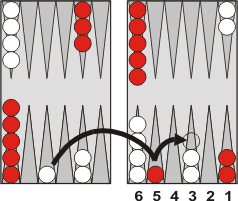
Any time a player has one or more checkers on the bar he has to bring them back in the game before he is allowed to move his other checkers again. The checker is moved into the opposing home board. The exact position is selected by the rolled numbers. In the example bellow white rolled a three and his checker enters the game at this position. If neither of the points is open, the player loses his turn. If a player is able to enter some but not all of his checkers, he must enter as many as he can.
After the last of a player’s checkers has been entered, any unused numbers on the dice must be played, by moving either the checker that was entered or a different checker.
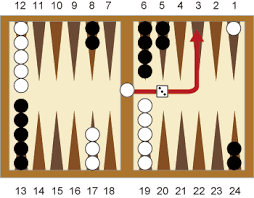
After a player has moved all 15 checkers into his home board he starts to bear them off. To find out which checkers are moved out the triangles in the home board are numbered. The one closest to the bar is the six and the one on the other side the one. The triangles in between are numbered from five to two in the correct order. The player rolls the dice and bears off his checkers regarding the numbers. If he rolls a six and a three he can bear off one checkers from the triangle with the number six and one of the one with the number three. If there are no checkers on the rolled number the player has to move within his home board. To do so he moves using a checker on a higher numbered point. If there are no checkers on higher-numbered points, the player is permitted to remove a checker from the highest point on which one of his checkers resides. A player is under no obligation to bear off if he can make an otherwise legal move.
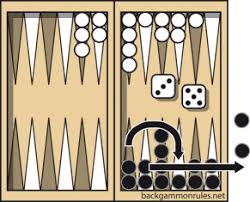
Have fun playing!

